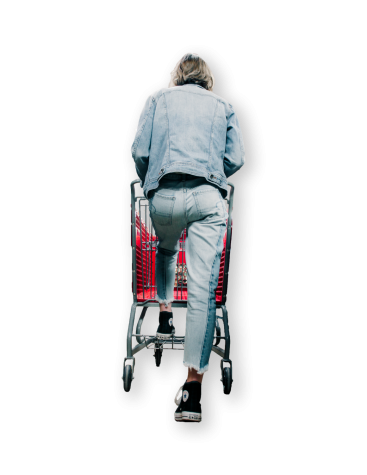Waste Size: the consequences of the modern-day fashion industry
According to Business Insider, H&M outsources most of its labor overseas, to countries like Bangladesh, where the working conditions are difficult to oversee and are often dangerous.
Today’s fashion industry is often consuming: Instagram models, Twitter clothing threads, online shopping, eye-catching advertisements — shopping is more saturated with choice and accessibility than it has ever been before. In fact, in 2015, the U.S. Congressional Joint Economic Committee reported that “consumers spent nearly $380 billion on apparel and footwear.” America is, as some would say, a fashion empire; in New York City alone, “fashion is a $98 billion industry, employing more than 5 percent of the city’s private-sector workforce,” the J.E.C. further reported.
Yet beneath the layers of sweaters, flowing sundresses, classic button-ups and denim jackets lies the question: How is all of this clothing made?
Woven into every piece of fabric are the effects of the modern fashion industry, starting with designers and continuing all the way to checkout counters. The clothing that you’re wearing right now may have trekked across the world, being sewn and stitched by hundreds of people or machines in handfuls of countries. This is the modern fashion industry many Americans are consumed by today, and whether it be high-end retail or inexpensive apparel, there is, undoubtedly, a lot to undress.
Fast fashion. As a rapidly growing trend right now, fast fashion has made a name for itself. “[It’s] an approach to the design, creation and marketing of clothing fashions that emphasizes making fashion trends quickly and cheaply available to consumers,” defines Merriam-Webster. These styles stem from the major runways and collections during each season, so something that, for example, designer Marc Jacobs fabricates in his spring 2019 collection will be copied, mass produced and sold in major stores just months after.
A simple Google search of the term “fast fashion” will produce thousands of results highlighting stores like Forever 21, H&M, ASOS, Zara, Mango — clothing stores that produce bulk amounts of clothing at extremely cheap prices.
“Fast fashion, to my understanding, is something that started in the last two decades, or has really increased significantly,” explained Ms. Dana Brady, the AP Biology teacher at LHS, as well as a passionate environmentalist. “Companies, or fashion magazines, are coming out with the new trends and they become very expensive for the layman, so [inexpensive fashion producers] crank out cheap material that is not good for the environment.”
According to the U.S. Environmental Protection Agency, this mass production of clothing causes major increases in textile waste, “material that is deemed unusable for its original purpose,” such as fashion and textile industry waste that is created during clothing production, as well as consumer waste.
Because these specific forms of clothing are purchased in bulk by millions of consumers, the consequences are felt across the world.
“A lot of petroleum-based products are used to make t-shirts, pants, etc.,” Ms. Brady further emphasized. “[The clothes] are poor quality. They’re not meant to last. They’re using materials that, when they’re produced, are harmful to the environment, and the production itself is [harmful] too.”

These fabrics, such as nylon, polyester and acrylic, are some of the most commonly manufactured petroleum-based fabrics in the fast fashion industry. According to the University of Queensland’s sustainability project, “the clothing and textile industry is depleting non-renewable resources, emitting huge quantities of greenhouses gases and using massive quantities of energy, chemicals and water.”
Junior Mark Plunkett and senior Jessica Mehra both expressed the importance of higher-quality fabric and manufacturing for their clothing purchases. For example, fabrics such as cotton are often considered more energy efficient, as cotton depends on water and sunlight for growth as opposed to chemicals and manufacturing, the Australian Energy Exchange outlined.
Plunkett explained how his clothing “is like an investment,” and he’s more willing to buy a more expensive item if he knows it’s higher-quality in material as well as manufacturing.
As many of those interviewed explained, much of their clothing purchased from fast fashion outlets like Forever 21 or Zara may rip or unravel easily, which can prevent them from donating their clothing, and thus they instead resort to discarding the clothing altogether. In fact, in 2015, the EPA reported that “landfills received 10.5 million tons of Municipal Solid Waste [in] textiles.” These textiles made up 7.6 percent of all MSW in that one year alone.
Ms. Brady even commented on how the fast fashion industry can often be cyclic: “People purchase [the clothing] at very reduced costs, wear them maybe once or twice and then throw them away.”
The environmental impacts expand even further — the fashion industry, particularly the fast fashion industry, hurts marine life as well. In a report by Forbes, they stated that “the fashion industry is the second biggest polluter of freshwater resources on the planet.”
These accumulated concerns inspire students like senior Linh Tran to make an effort towards buying recycled or second-hand clothing.
“I try my best to always buy things with the intention of being eco-friendly,” Tran explained. “I don’t like to shop at fast fashion stores. I buy the majority of my clothing second-hand or from ethical brands.”
Mehra and Plunkett both noted they occasionally shop at thrift stores and consignment stores. However, Tran noted that she will shop at thrift stores more often than buying directly from recognized ethical brands, as the more popular ethical brands, such as Patagonia, Everland and American Apparel, are often quite expensive.
For some, fashion is an extremely distinct statement, and many brands deemed fast fashion outlets produce apparel that fits to wide ranges of styles and personal aesthetics.
Junior Shea Brennan shops often at Forever 21 “because there’s a wide spectrum of clothes that you can choose from… it’s cheap too, it’s really cheap, and if I spill something on a shirt, I wouldn’t be that mad with spilling [something] on a $10 shirt compared to a $50 shirt.”
That affordability in fast fashion apparel can be a large selling point for individuals, as many interviewed noted that not everyone is able to afford more eco-friendly alternatives, such as ethically sourced clothing brands.
“You have to consider people’s incomes, and how much they’re able to spend on certain things,” Brennan noted, adding that eco-friendly shopping should be more encouraged for some people.
Tricia Regan, co-owner of the Libertyville consignment store ReNew, noticed the vast amount of thrift shops and consignments stores for just clothing in the area, and established ReNew for the resale of used textile products such as “recycled handbags, home decor, jewelry and furniture.” Regan noted how much of their inventory is higher-end, thus allowing customers to purchase more luxurious, used goods at a reasonable price.
Resale of recycled and reused textiles, especially clothing, can be extremely beneficial to ecosystems on both a local and global scale. According to a study conducted by the Swedish Environmental Protection Agency, in 2014, reused or recycled clothing from the major Swedish second-hand, nonprofit organization Emmaus Björkå saved an estimated 947,000 cubic meters of clean water, roughly equivalent to a 300-year-long shower. When more clothing is donated and purchased through resale, that lessens the environmental impact through recycling, the report further explained.
As the global market expands, so does a consumer’s access to various fashion brands. And there are many layers to fast fashion: styles that are sold at cheaper prices benefit individuals that can’t afford expensive retail though the environmental pollution is felt across the world. However, the understanding of the consequences of the fast fashion industry inspired many of the students interviewed to take a closer look into the clothes they buy and the stores they buy them from.
Brennan concluded that the next time she steps into stores such as Forever 21 or H&M, “I’ll be thinking about the pollution. I’ll buy the clothes I need to buy, but the pollution will be in the back of my mind.”









